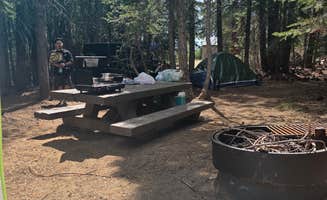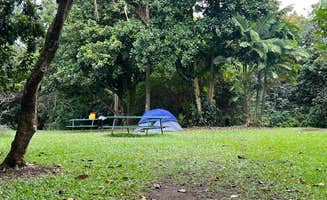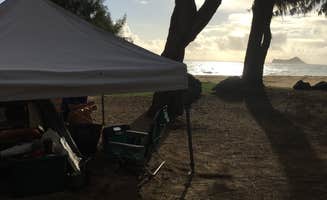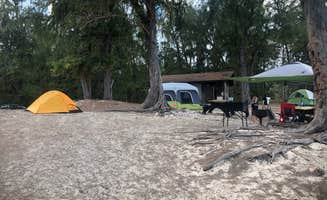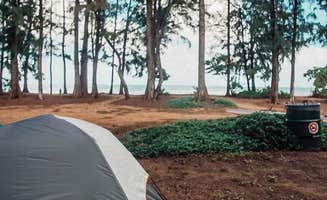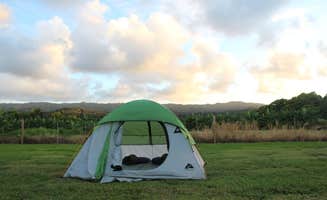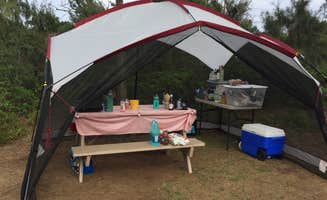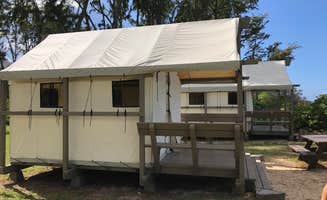Camping near Honolulu offers diverse terrain beyond the well-known beaches, with inland options ranging from 500-1,000 feet elevation in the Ko'olau Mountains. Temperature variations can be significant, with mountain campgrounds often 5-10°F cooler than coastal sites and receiving up to three times more rainfall. Many campgrounds impose strict arrival time limits, with gates closing as early as 7:00 pm at some locations.
What to do
Hiking with mountain views: At Ho'omaluhia Botanical Garden, campers can access trails with views of the Ko'olau Mountain Range. "There are few sites on island that are not connected to the beach. This place offers different features that make for a fun stay," notes a camper. The area receives significant rainfall, creating a lush environment for hiking.
Water activities beyond swimming: Kahana Campground provides access to both ocean and river activities. "They have volleyball, tubing, rope swings, snorkeling, just to name a few. This place is also super green. It receives the most rain anywhere in Oahu," shares one visitor. The bay is protected, making it suitable for paddleboarding and kayaking.
Adventure sports access: Camp Mokuleia puts you within walking distance of rock climbing opportunities. "This campground is very close to the highest concentration of rock climbs in all of Hawaii! The Mokule'ia wall has over 60 climbs ranging from beginner to expert and includes trad, sport, and toprope routes," explains one experienced climber. The proximity to Ka'ena Point also offers unique hiking with ocean views.
What campers like
Protected beaches for swimming: Mālaekahana State Recreation Area offers calmer swimming conditions than many north shore locations. "If you are looking for a campsite next to the beach this is the one to see. It is lovely waking up to the sound of the waves hitting the beach," one camper reports. Sites directly on the beach allow immediate water access.
Security features: Some campgrounds provide better security than others. Camp Mokuleia has implemented controlled access. "The property has a gate with a code that you can go in and out as you please, and the staff were really helpful and kind," reports one camper. During COVID restrictions, they assigned private bathrooms with keys to individual sites.
Unique accommodations: Beyond tent camping, options include cabins and yurts. "There are cabins and apartments for rent if you have base access. I stayed in a cabin near the beach, it was small and clean," notes a reviewer about Bellows Air Force Station. Many military facilities require reservations up to a year in advance.
What you should know
Military ID requirements: Several campgrounds restrict access to military personnel and their guests. "There is actually both a civilian and military campground. The civilian side is for the true camping enthusiast. The military side has both campgrounds and cabins, with a mini golf course and a mini-mart," explains a camper about Bellows Field Beach Park. Civilians can still access designated areas at some military-affiliated sites.
Crowding patterns: Weekday camping offers more solitude. "We lucked out and there were not many campers in the park after 8pm. However during the day this Regional Park does get very crowded with weekend activities, parties, and tourists," reports a visitor to Kualoa A Regional Park. Many locals use these parks for day events.
Pet regulations vary: Contrary to some listings, Hawaii state campgrounds have strict pet policies. "This website is in error. There are no dogs allowed on ANY Hawaii State Campground!!! Don't know if you know this or not. So if you have a dog in Hawaii, you cannot bring your loved one(s) camping anywhere," warns a visitor to Bellows Field. Always verify current pet policies before booking.
Tips for camping with families
Beach selection for children: Sand Island State Recreation Area offers calmer waters. "Sand Island is an industrial place so there's not many stores nearby but it's a pretty unique park with lots of space to hangout. The beach isn't the nicest but it's good for little kids," shares a visitor. The relative seclusion means fewer crowds competing for space.
Bug preparation: Insects vary significantly between locations. "Besides the loud music during the day which wasn't to bothersome because that campsite was at the end, it was a great stay. Only suggestion is to bring fly tape or fly traps. A screen tent would be a superb addition," advises a camper at Bellows Field Beach Park. Coastal sites generally have fewer insects than inland locations.
Amenities for children: Some campgrounds offer recreational facilities beyond beaches. "Tons of amenities here though, putt-putt, driving range, bar w/ pool table, foose, beach equipment rental, paint ball, small bouldering area!" notes a visitor to Bellows Air Station. These extra activities provide options during rainy periods.
Tips from RVers
Site spacing considerations: RV sites at most Honolulu area campgrounds are tightly arranged. "Tent campsites are way too close together! Every 2 sites should be combined to make 1. Ocean view sites are very sandy and if you are near the restroom, be prepared for beach goers to walk right through your site to use the toilet," warns a visitor to Bellows Air Force Station. Consider booking during weekdays for more space.
Limited hookup availability: Most camping honolulu hawaii sites lack full RV hookups. "The bathrooms are pretty good as far as camp bathrooms go," notes a camper at Kahana Campground. Even campgrounds that allow RVs typically offer primitive camping without water or electrical connections.
Gate closure times: Gate restrictions affect late arrivals. "Gates close at 7:00 pm. Watch out for centipedes; I got bit and it was extremely painful," warns a camper about Malaekahana. Plan arrival times carefully, as many campgrounds strictly enforce closure hours with no late entry allowed.


